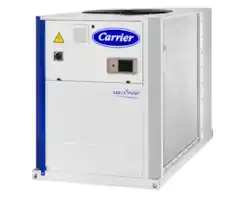16 April 2021
|
ADVERTORIAL: Andy Legg, Carrier UK’s product manager for chillers and heat pumps, highlights recent system refinements that are delivering major improvements in performance for R-32 systems – with benefits for end users and the environment
There was an understandable rush to adopt the lower Global Warming Potential (GWP) refrigerant R-32 when it was first proposed as a replacement for higher GWP R-410A in chillers and heat pumps.
With a GWP of 675 compared to 2088 for R-410A, R-32 offers a major step forward in environmental protection.
Early adoption of new technologies, however, can come at a cost, as anyone who invested in a shiny new Betamax video system back in the ‘70s will tell you. There are often unforeseen issues and wrinkles to iron out, and it may take time to fully harness the benefits of new materials and technology.
Not all is equal
This has proved to be the case with R-32. It is clear that chillers and heat pumps operating on R-32 are not all equal. Some early examples were not fully optimised to operate on the new refrigerant, resulting in lower efficiency and higher running costs than are now possible with the latest generation of systems.
The move to more environmentally conscious options is a priority, and the industry has been highly proactive in responding to the challenge. The risk of prioritising speed to market rather than the performance of the product, however, is that sub-optimal design may exacerbate the problem the solution was intended to address.
The majority of a chiller’s carbon footprint results from energy consumption during operation throughout the product lifetime. The greenhouse gas emissions from chiller operation are dependent on the local fuel source, and globally, the majority power plants are run on greenhouse gas emitting fossil fuels.
While there are global efforts to transition to renewable energy sources aligned with the Paris Agreement, chiller energy efficiency remains an important factor in addressing climate change. According to the International Energy Agency, without action to address energy efficiency, energy demand for space cooling will more than triple by 2050 – consuming as much electricity as all of China and India today.
The reality is that power consumed accounts for some 80% of a chiller’s carbon emissions. The refrigerant makes up the remaining 20%. In switching to more environmentally acceptable refrigerants, therefore, it is important to ensure that not only is the refrigerant’s GWP as low as possible, and the charge as small as possible, but – critically – that equipment is as energy efficient as possible.
Fully optimised systems
This is the approach that Carrier adopted in optimising the design of its AquaSnap chillers and heat pumps to operate on R-32. It required going back to the drawing board to ensure systems were fully optimised at every stage in the thermodynamic cycle, with careful component selection and testing to ensure the best possible match for the unique properties of the refrigerant
The good news is that, due to its operating characteristics, R-32 is up to 10% more efficient than R-410A. And its carbon-equivalent emission rating is 68% lower. Delivering this theoretical advantage to the greatest possible extent, however, requires careful system design and optimisation.
For example, scroll compressors used on Carrier chillers are designed specifically for use with R32. Due to improvements in engineering and design, they operate at maximum efficiency at minimum and part load conditions, which in many applications is the majority of the time. This results in a significant improvement in overall energy efficiency and lower operating costs.
Further efficiency improvements are made possible by the use of the latest second generation V-shape Novation micro-channel heat exchangers. Exclusive to Carrier, these all-aluminium components are not only highly efficient in transferring heat but help reduce refrigerant charge by 40% versus standard copper / aluminium coils.
The heat exchangers are paired with the latest high performance 6th generation Flying Bird fans, which have a new multi-blade design for improved aerodynamic performance. Accurate load matching is assisted by the use of variable-speed condenser fans and pumps.
Brazed plate heat exchangers with asymmetric channels are used not only for their efficiency but to reduce pressure drop and minimise the risk of fouling on the water side. Their true dual-circuit design also assists performance in both full and part-load conditions.
To provide enhanced resilience, chillers use multiple stage compressors operating in two independent refrigeration circuits. This enables them to continue operating in the unlikely event of a compressor failing. It also limits the risk of refrigerant leakage in the case of accidental damage.
Overall, as a result of system design improvements and careful component selection, the refrigerant carbon footprint of our commercial scroll chillers and heat pumps operating on R-32 has been reduced by up to 80%. This reflects the refrigerant’s lower GWP and reduction in charge compared to the previous generation using R-410A.
Seasonal Energy Efficiency Ratio
In terms of energy efficiency, the chillers achieve an outstanding Seasonal Energy Efficiency Ratio (SEER 12/7) of up to 5.33 for cooling, and a Seasonal Coefficient of Performance (SCOP) of up to 3.77 for heating. This exceeds Ecodesign 2021 requirements by some 20%.
As a result, use of Carrier R-32 chillers and heat pumps attracts two BREEAM points when installed in environmentally assessed buildings. This enables end users to achieve the highest environmental standards in use today.
In summary, Carrier has gone back to the drawing board and taken time to research and test how best to harness the properties of this new refrigerant, and developed fully optimised systems that deliver the best possible performance.
The result is one of the most energy efficient and reliable ranges of R32-based chillers and heat pumps available. AquaSnap units save energy, cut running costs, reduce building carbon emissions, help protect the environment and, due to their resilience, ensure continuity of cooling for buildings and critical process applications.
And they are available in capacities from 40 to 940kW (up to 550kW for heat pumps), which we believe is the widest Eurovent-certified range currently on the market.
www.carrier.com/commercial/en/uk/
Optimising Chillers and Heat Pumps for use with R-32
Andy Legg, Carrier UK’s product manager for chillers and heat pumps, highlights recent system refinements that are delivering major improvements in performance for R-32 systems – with benefits for end users and the environment
There was an understandable rush to adopt the lower Global Warming Potential (GWP) refrigerant R-32 when it was first proposed as a replacement for higher GWP R-410A in chillers and heat pumps.
With a GWP of 675 compared to 2088 for R-410A, R-32 offers a major step forward in environmental protection.
Early adoption of new technologies, however, can come at a cost, as anyone who invested in a shiny new Betamax video system back in the ‘70s will tell you. There are often unforeseen issues and wrinkles to iron out, and it may take time to fully harness the benefits of new materials and technology.
Not all is equal
This has proved to be the case with R-32. It is clear that chillers and heat pumps operating on R-32 are not all equal. Some early examples were not fully optimised to operate on the new refrigerant, resulting in lower efficiency and higher running costs than are now possible with the latest generation of systems.
The move to more environmentally conscious options is a priority, and the industry has been highly proactive in responding to the challenge. The risk of prioritising speed to market rather than the performance of the product, however, is that sub-optimal design may exacerbate the problem the solution was intended to address.
The majority of a chiller’s carbon footprint results from energy consumption during operation throughout the product lifetime. The greenhouse gas emissions from chiller operation are dependent on the local fuel source, and globally, the majority power plants are run on greenhouse gas emitting fossil fuels.
While there are global efforts to transition to renewable energy sources aligned with the Paris Agreement, chiller energy efficiency remains an important factor in addressing climate change. According to the International Energy Agency, without action to address energy efficiency, energy demand for space cooling will more than triple by 2050 – consuming as much electricity as all of China and India today.
The reality is that power consumed accounts for some 80% of a chiller’s carbon emissions. The refrigerant makes up the remaining 20%. In switching to more environmentally acceptable refrigerants, therefore, it is important to ensure that not only is the refrigerant’s GWP as low as possible, and the charge as small as possible, but – critically – that equipment is as energy efficient as possible.
Fully optimised systems
This is the approach that Carrier adopted in optimising the design of its AquaSnap chillers and heat pumps to operate on R-32. It required going back to the drawing board to ensure systems were fully optimised at every stage in the thermodynamic cycle, with careful component selection and testing to ensure the best possible match for the unique properties of the refrigerant
The good news is that, due to its operating characteristics, R-32 is up to 10% more efficient than R-410A. And its carbon-equivalent emission rating is 68% lower. Delivering this theoretical advantage to the greatest possible extent, however, requires careful system design and optimisation.
For example, scroll compressors used on Carrier chillers are designed specifically for use with R32. Due to improvements in engineering and design, they operate at maximum efficiency at minimum and part load conditions, which in many applications is the majority of the time. This results in a significant improvement in overall energy efficiency and lower operating costs.
Further efficiency improvements are made possible by the use of the latest second generation V-shape Novation micro-channel heat exchangers. Exclusive to Carrier, these all-aluminium components are not only highly efficient in transferring heat but help reduce refrigerant charge by 40% versus standard copper / aluminium coils.
The heat exchangers are paired with the latest high performance 6th generation Flying Bird fans, which have a new multi-blade design for improved aerodynamic performance. Accurate load matching is assisted by the use of variable-speed condenser fans and pumps.
Brazed plate heat exchangers with asymmetric channels are used not only for their efficiency but to reduce pressure drop and minimise the risk of fouling on the water side. Their true dual-circuit design also assists performance in both full and part-load conditions.
To provide enhanced resilience, chillers use multiple stage compressors operating in two independent refrigeration circuits. This enables them to continue operating in the unlikely event of a compressor failing. It also limits the risk of refrigerant leakage in the case of accidental damage.
Overall, as a result of system design improvements and careful component selection, the refrigerant carbon footprint of our commercial scroll chillers and heat pumps operating on R-32 has been reduced by up to 80%. This reflects the refrigerant’s lower GWP and reduction in charge compared to the previous generation using R-410A.
Seasonal Energy Efficiency Ratio
In terms of energy efficiency, the chillers achieve an outstanding Seasonal Energy Efficiency Ratio (SEER 12/7) of up to 5.33 for cooling, and a Seasonal Coefficient of Performance (SCOP) of up to 3.77 for heating. This exceeds Ecodesign 2021 requirements by some 20%.
As a result, use of Carrier R-32 chillers and heat pumps attracts two BREEAM points when installed in environmentally assessed buildings. This enables end users to achieve the highest environmental standards in use today.
In summary, Carrier has gone back to the drawing board and taken time to research and test how best to harness the properties of this new refrigerant, and developed fully optimised systems that deliver the best possible performance.
The result is one of the most energy efficient and reliable ranges of R32-based chillers and heat pumps available. AquaSnap units save energy, cut running costs, reduce building carbon emissions, help protect the environment and, due to their resilience, ensure continuity of cooling for buildings and critical process applications.
And they are available in capacities from 40 to 940kW (up to 550kW for heat pumps), which we believe is the widest Eurovent-certified range currently on the market.
www.carrier.com/commercial/en/uk/










